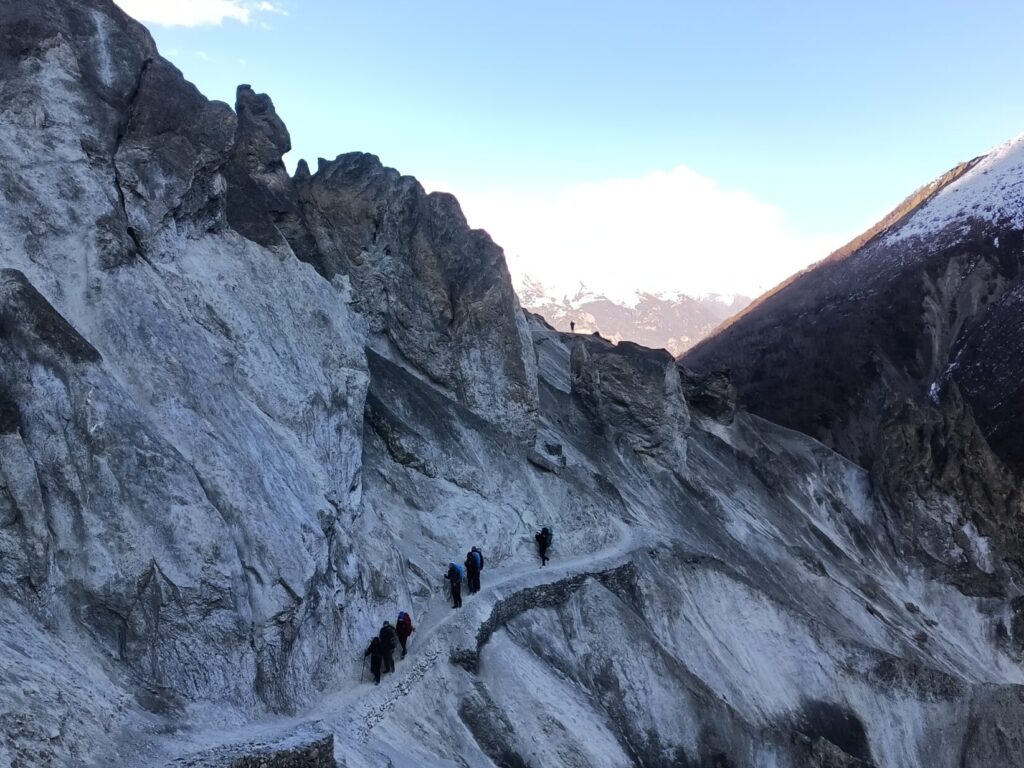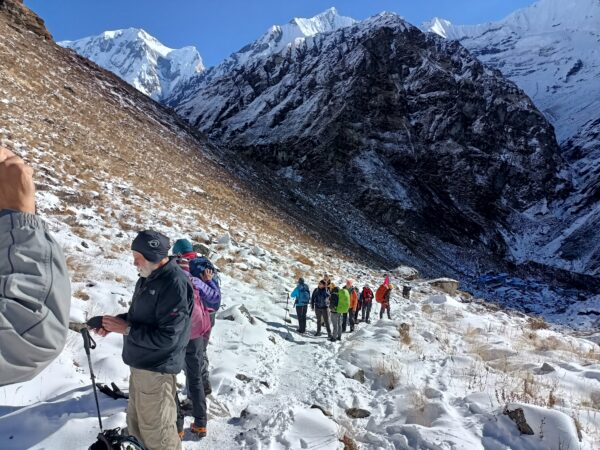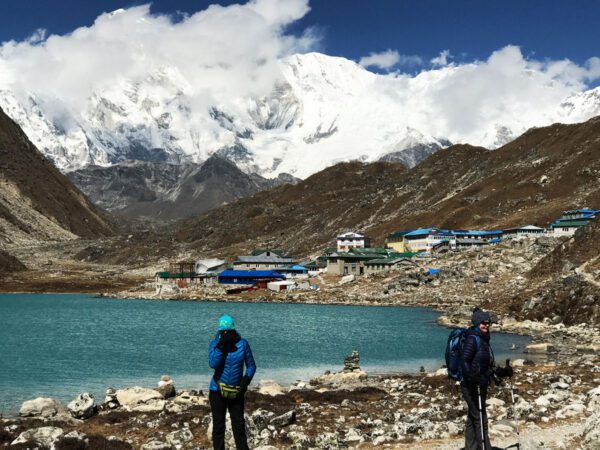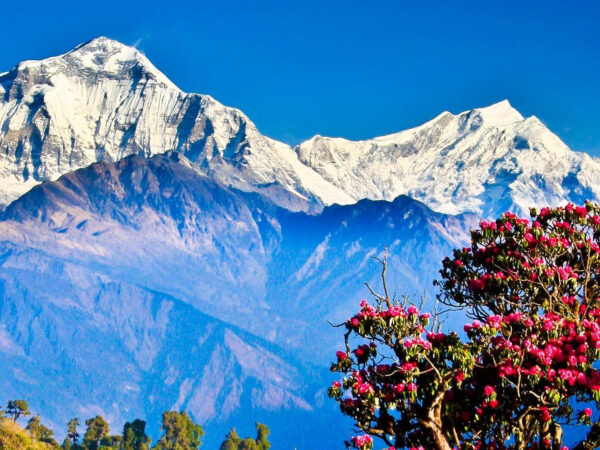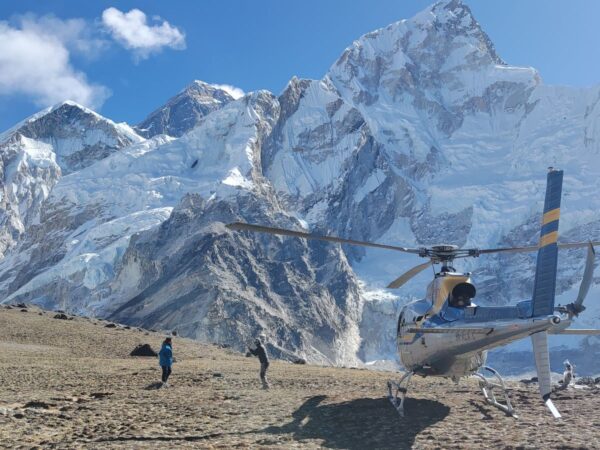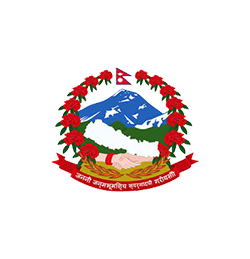Highlights
- Thorong La Pass (5,416m): Cross the world’s widest mountain pass and marvel at the panoramic views of the snow-capped Himalayas.
- Tilicho Lake (4,910m): Visit the world’s highest lake, a serene and spiritual gem surrounded by towering peaks.
- Diverse Landscapes: Experience everything from subtropical lowlands to alpine forests, glacial lakes, and arid highlands.
- Cultural Immersion: Interact with people from various ethnic groups and explore their unique traditions, heritage, and warm hospitality.
- Sacred Sites: Visit the Muktinath Temple, a revered pilgrimage site for Hindus and Buddhists.
- Hot Springs at Tatopani: Soothe your tired muscles in natural hot water springs after days of trekking.
- Stunning Viewpoints: Witness unforgettable Himalayan sunrises from Poon Hill and other spots along the trail.
- Natural Wonders: Discover stunning gorges, glaciers, and waterfalls that add a magical touch to the adventure.
Overview
The Annapurna Circuit with Tilicho Lake Trek is one of the most breathtaking and rewarding adventures in the Annapurna region. This classic trek seamlessly blends the iconic Annapurna Circuit with a visit to Tilicho Lake, the highest lake in the world, creating an unforgettable journey through diverse landscapes, cultures, and experiences.
The trek begins with a scenic drive to Dharapani, where you’ll start your ascent from lush paddy fields. As you follow the Marshyangdi River, the trail takes you through dense oak and pine forests, eventually transitioning into the stark, high-altitude desert of Manang (3,597m). From here, the journey diverges from the usual Annapurna Circuit route, leading you westward to the serene Tilicho Lake (4,910m), passing through Khanshar Village, also known as “The Last Village of Nepal.” After visiting Tilicho Lake, the trail rejoins the circuit to conquer the famed Thorong La Pass (5,416m).
Trekking Challenges and Preparation
The Annapurna Circuit with Tilicho Lake Trek is an exhilarating but physically demanding adventure. Here’s what to expect and how to prepare:
Trekking Difficulties
- Long Days of Hiking: Be prepared to trek 7–8 hours daily over varying terrains for more than two weeks.
- High Altitude Conditions: With elevations exceeding 5,000 meters, proper acclimatization is crucial to avoid altitude sickness.
- Challenging Terrain: The route includes steep ascents, descents, rugged trails, and traverses through diverse environments, from alpine forests to glacial regions.
Fitness and Training
This trek demands good physical fitness and stamina. While previous trekking experience is an advantage, it’s not mandatory. Prepare for the trek by:
- Cardiovascular Training: Engage in activities like hiking, jogging, cycling, or swimming.
- Strength and Endurance Workouts: Focus on leg strength and overall stamina to handle long days on uneven terrain.
- Mental Preparation: Trekking can be as mentally challenging as it is physical, so maintaining a positive mindset is key.
Start training two to three months in advance or, at the very least, dedicate two weeks to regular exercise before your trek.
Packing and Accommodation
- Expect basic food and lodging along the trail. Simple meals and tea houses provide the essentials, but luxuries are minimal.
- Pack appropriately for varying weather conditions, including warm layers, waterproof gear, and sturdy hiking boots.
Why Choose the Annapurna Circuit with Tilicho Lake Trek?
This trek is a perfect blend of natural beauty, cultural discovery, and personal challenge. From the awe-inspiring views of the Annapurna Range to the spiritual stillness of Tilicho Lake, every step is a unique experience. While it requires preparation and effort, the rewards—both external and internal—are unparalleled.
Outline Itinerary
Day 01: Arrival in Kathmandu (1,400 m)
Day 02: Drive to Dharapani (1,920 m) via Besisahar – 7 hours
Day 03: Trek to Chame (2,670 m) – 5 hours
Day 04: Trek to Pisang (3,230 m) – 5 hours
Day 05: Trek to Manang (3,450 m) – 5 hours
Day 06: Acclimatization Day in Manang
Day 07: Trek to Khangsar (3,734 m) – 5 hours
Day 08: Trek to Tilicho Base Camp (3,900 m) – 4 hours
Day 09: Visit Tilicho Lake (4,919 m) and Trek to Siri Kharka (4,010 m) – 6 hours
Day 10: Trek to Yak Kharka (4,110 m) – 5 hours
Day 11: Trek to Thorong High Camp (4,600 m) – 4 hours
Day 12: Cross Thorong-La Pass (5,416 m) and Descend to Muktinath (3,800 m) – 7 hours
Day 13: Fly or Drive to Pokhara
Day 14: Drive or Fly Back to Kathmandu
Day 15: Departure from Kathmandu
Tips: If you’re looking for a shorter or less demanding version of the Annapurna Circuit, the standard Annapurna Circuit Trek—without the side trip to Tilicho Lake—offers a fantastic alternative. It still includes all the iconic landscapes, diverse cultures, and the thrill of crossing Thorong La Pass, while saving time and effort.
Annapurna Circuit with Tilicho Lake Trek - Itinerary
Arrival in Kathmandu (1,400 m)
Welcome to Nepal! Upon arrival at Kathmandu International Airport, our team will greet you and transfer you to your hotel. In the evening, we’ll introduce you to your guide, who will brief you about the trek and help check your gear to ensure you're fully prepared for the adventure ahead.
Drive to Dharapani (1,920 m) via Besisahar – 7 hours
After breakfast, we set off on a scenic drive out of the Kathmandu Valley, passing lush green hills, terraced fields, and glimpses of snow-capped peaks. As we reach Besisahar, the gateway to the Annapurna region, the drive transitions to an off-road journey through picturesque villages. By evening, we’ll arrive at Jagat, a charming hillside village and then Dharapani, where we’ll spend the night.
Trek to Chame (2,670 m) – 5 hours
Today’s trek takes us through rhododendron and pine forests, passing small settlements like Bagarchap and Timang, where we’ll enjoy breathtaking views of Mt. Manaslu. Our journey continues to Chame, the administrative center of the Manang district, known for its warm hospitality and panoramic mountain vistas.
Trek to Pisang (3,230 m) – 5 hours
The trail gradually ascends as we trek closer to the mountains. We’ll cross rivers, meander through alpine forests, and enjoy spectacular views of peaks like Chulu and Pisang. By afternoon, we’ll descend into the quaint village of Pisang, surrounded by towering cliffs and snow-capped mountains.
Trek to Manang (3,450 m) – 5 hours
From Pisang, the path gently climbs, offering stunning views of Annapurna II, III, and Gangapurna. Along the way, we’ll visit the ancient Braga Monastery, home to beautiful wall paintings and relics. The day ends in Manang, a vibrant village nestled beneath towering peaks, where we’ll rest for the night.
Acclimatization Day in Manang
We’ll spend the day in Manang to acclimatize to the higher altitude. Take a short hike to Gangapurna Glacier or the glacial lake, explore the village, and soak in the breathtaking Himalayan scenery. Rest well, as the adventure intensifies from here!
Trek to Khangsar (3,734 m) – 5 hours
Leaving Manang, we diverge from the main Annapurna Circuit trail and venture towards Tilicho Lake. Today’s trek takes us through remote landscapes and serene trails to Khangsar, the last inhabited village before Tilicho Lake.
Trek to Tilicho Base Camp (3,900 m) – 4 hours
The path becomes rugged as we make our way to Tilicho Base Camp. Along the way, we’ll witness awe-inspiring views of Gangapurna and Tilicho Peaks. The trail, dotted with juniper bushes, leads us to Base Camp, surrounded by a dramatic mountain backdrop.
Visit Tilicho Lake (4,919 m) and Trek to Siri Kharka (4,010 m) – 6 hours
Today is the highlight of our trek! We hike to Tilicho Lake, the world’s highest lake, surrounded by majestic peaks. The turquoise waters of the lake are simply magical. After soaking in the serene beauty and capturing unforgettable moments, we descend to Siri Kharka for the night.
Trek to Yak Kharka (4,110 m) – 5 hours
The trail gradually ascends through beautiful landscapes, offering spectacular views of the Annapurna range. We pass grazing yaks and small alpine settlements before reaching Yak Kharka, a tranquil stop along our route to the Thorong-La Pass.
Trek to Thorong High Camp (4,600 m) – 4 hours
The journey continues uphill as we approach the base of Thorong-La Pass. After crossing a suspension bridge and following the Jarjung River, we’ll reach Thorong Phedi. A final climb takes us to High Camp, where we’ll rest and prepare for tomorrow’s big day.
Cross Thorong-La Pass (5,416 m) and Descend to Muktinath (3,800 m) – 7 hours
We start early to conquer the highest point of the trek, Thorong-La Pass. Standing at 5,416 meters, the pass offers breathtaking views of the Himalayas. After celebrating this incredible feat, we descend to Muktinath, a sacred pilgrimage site for Hindus and Buddhists, where we’ll spend the night.
Fly or Drive to Pokhara
From Muktinath, we drive to Jomsom and take a short flight to Pokhara. Alternatively, you can opt for a scenic drive, passing through Tatopani and Beni. In Pokhara, unwind by the serene Phewa Lake and reflect on your amazing journey.
Drive or Fly Back to Kathmandu
We return to Kathmandu, either by road or a quick domestic flight. Upon arrival, the rest of the day is yours to explore the city, shop for souvenirs, or simply relax.
Departure from Kathmandu
As your unforgettable journey comes to an end, we’ll transfer you to the airport for your flight home. Take with you cherished memories of the Annapurna Circuit and Tilicho Lake adventure, and we hope to see you again!
Inclusions
What's included
- Airport transfers - pickup and drop off
- An Experience English speaking guide
- All Meals during the trek
- Teahouse accommodation during the trek
- Kathmandu to Besishahar by Bus and Dharapani by shared jeep
- Muktinath to Pokhara local bus and Pokhara to Kathmandu by tourist bus
- All required trekking permits (Annapurna Conservation Area Fee, and TIMs card)
- Guide insurance with food and accommodation Basic Medical kits Sleeping and duffel bag, down jacket, trekking poles (should be returned after the trek)
- Farewell dinner
- Emergency Helicopter Evacuation Service Arrangement Only (should cover by your travel insurance)
- All required paper works and government taxes
What's not included
- International Flight
- Nepal Travel
- Visa Fee
- Personal Medical and Travel insurance (Should cover helicopter evacuation).
- Guide, Porter and Driver tips Personal Gears (equipment) Personal bill Lunch and Dinner in Kathmandu .
- All other personal expense of beverages (hard and soft drinks).
- Porter
- All other things not mentioned in the inclusion.
Equipment
Recommended Trekking Gears
Clothing
- Base Layers (Moisture-Wicking)
- Thermal tops and bottoms (polyester or merino wool)
- Lightweight long-sleeve shirts
- Insulating Layers
- Fleece jacket or pullover
- Down jacket (for high-altitude treks)
- Warm sweaters
- Outer Layers (Shells)
- Waterproof and windproof jacket (Gore-Tex or similar)
- Waterproof pants
- Trekking Pants
- Quick-dry pants
- Convertible hiking pants (zip-off into shorts)
- Trekking Shirts
- Lightweight and breathable T-shirts
- Long-sleeve shirts with UV protection
- Headwear
- Wide-brim hat or cap for sun protection
- Warm beanie for cold temperatures
- Buff or scarf for dust and wind
- Gloves
- Lightweight trekking gloves
- Insulated gloves for higher altitudes
- Socks
- Moisture-wicking trekking socks
- Thermal socks for colder regions
- Footwear
- Sturdy and waterproof trekking boots (well broken-in)
- Comfortable sandals or camp shoes (for evenings/rest days)
- Gaiters (optional, for snow or muddy trails)
Backpacks & Bags
- Backpack
- 40-50L capacity for multi-day treks
- Comfortable straps and rain cover
- Daypack
- 20-30L for short treks or carrying essentials during the day
- Duffel Bag
- Used if porters are carrying your gear (for organized treks)
- Dry Bags
- To keep electronics and clothes dry in wet conditions
Sleeping Gear
- Sleeping Bag
- 4-season sleeping bag (rated for -10°C to -20°C for high-altitude treks)
- Sleeping bag liner (optional, for extra warmth and hygiene)
- Sleeping Pad (if camping)
- Lightweight and inflatable or foam pads for comfort
Trekking Accessories
- Trekking Poles
- Adjustable and lightweight poles (essential for steep ascents/descents)
- Water Bottle/Hydration System
- Insulated bottle (to prevent freezing at high altitudes)
- CamelBak or similar hydration reservoir
- Water Purification
- Water filters, purification tablets, or UV sterilizers
- Sunglasses
- UV protection (Category 3 or 4 for snowy conditions)
- Headlamp
- With spare batteries (essential for early morning or late-night treks)
- Multi-tool or Knife
- For various small tasks
- First Aid Kit
- Bandages, blister patches, antiseptic wipes, painkillers, Diamox (for altitude sickness), etc.
- Lip Balm
- SPF-protected to prevent chapping
- Sunscreen
- High SPF for UV protection at higher altitudes
- Personal Toiletries
- Biodegradable soap, toothpaste, toothbrush, quick-dry towel, wet wipes, and toilet paper
Optional but Useful Items
- Camera
- To capture the stunning scenery (extra batteries and memory cards are a must)
- Snacks
- Energy bars, trail mix, or chocolate for quick energy boosts
- Power Bank/Solar Charger
- For charging devices in remote areas
- Books or E-Readers
- For downtime during rest days
- Earplugs
- To block out noise in lodges or camps
- Notebook/Journal
- To record your trek experience
Clothing Packing Tips
- Layering is key: It helps regulate your body temperature and adapt to changing weather.
- Avoid cotton: It retains moisture and dries slowly, which can lead to discomfort or hypothermia.
- Pack light: Only carry what is absolutely necessary to avoid unnecessary weight.
Gear Rentals in Nepal
If you're worried about carrying too much gear, trekking hubs like Kathmandu and Pokhara offer trekking equipment rentals and sales. You can find items like sleeping bags, down jackets, and trekking poles at reasonable prices. However, ensure you check the quality before renting.

